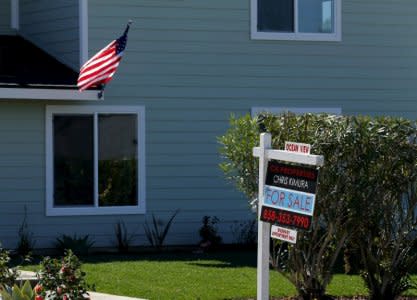U.S. housing starts jump to near 11-year high, permits fall

Thomson Reuters
By Lucia Mutikani
WASHINGTON (Reuters) - U.S. homebuilding surged to near an 11-year high in May amid an acceleration in both single-family and multi-family home construction, but a second straight monthly drop in permits suggested housing market activity would remain moderate.
Housing starts vaulted 5.0 percent to a seasonally adjusted annual rate of 1.350 million units last month, the Commerce Department said on Tuesday. That was the highest level since July 2007. Data for April was revised slightly to show starts falling to a rate of 1.286 million units instead of the previously reported pace of 1.287 million units.
Building permits fell 4.6 percent to a rate of 1.301 million units, the lowest level since September 2017. Economists polled by Reuters had forecast housing starts rising to a pace of 1.310 million units last month and permits declining to a rate of 1.350 million units.
Single-family homebuilding, which accounts for the largest share of the housing market, increased 3.9 percent to a rate of 936,000 units last month.
Single-family home construction rose in the Northeast and Midwest, but fell in the South and West. It has lost momentum since hitting a pace of 948,000 units last November, which was the strongest level in more than 10 years.
Permits to build single-family homes fell 2.2 percent in May to a pace of 844,000 units, an eight-month low. With permits lagging starts, single-family homebuilding could slow in the months ahead.
Yields on U.S. Treasuries held at lower levels after the data. U.S. stock index futures were trading sharply lower as U.S.-China trade tensions escalated, while the dollar <.DXY> was stronger against a basket of currencies.
MORE EXPENSIVE LUMBER
A survey on Monday showed confidence among single-family homebuilders dipped in June, with builders "increasingly concerned that tariffs placed on Canadian lumber and other imported products are hurting housing affordability." According to the survey, more expensive lumber had "added nearly $9,000 to the price of a new single-family home since January 2017."
The Trump administration in April 2017 imposed anti-subsidy duties on imports of Canadian softwood lumber. The higher cost of lumber together with a lack of land and labor has worsened an acute shortage of homes for sale, hobbling the housing market.
Residential investment contracted in the first quarter. The housing market continues to lag overall economic growth, which appears to be accelerating in the second quarter after hitting a speed bump at the start of the year.
Starts for the volatile multi-family housing segment rebounded 7.5 percent to a rate of 414,000 units in May. Permits for the construction of multi-family homes fell 8.8 percent to a pace of 457,000 units.
The housing shortage could ease, with more houses under construction and being completed. Housing completions increased 1.9 percent to a rate of 1.291 million units, the highest level since January 2008. The number of single-family houses completed last month was the most since March 2008.
Realtors estimate that housing start and completion rates need to be in a range of 1.5 million to 1.6 million units per month to plug the inventory gap.
The stock of housing under construction edged up 0.2 percent to 1.127 million units, the highest level since July 2007. Single-family homes under construction last month increased 0.2 percent to 515,000 units, the highest level since May 2008.
(Reporting by Lucia Mutikani; Editing by Paul Simao)
See Also:

 Yahoo News
Yahoo News 
